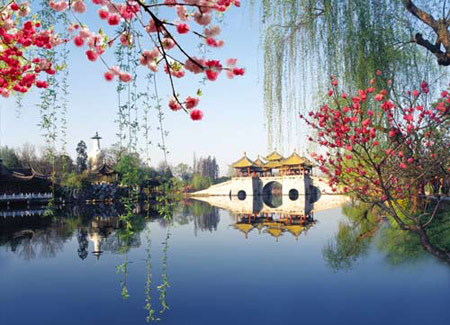
Flowers bloom near Slim West Lake, an icon of Yangzhou. (File Photo)
Top scenic spots in southern China have lowered prices to attract tourists back to areas pummeled by blizzards in January and February.
Some scenic spots received no visitors for 20 consecutive days during and after the worst weather in 50 years, while many others suffered a dramatic drop in business.
The total loss across the country is estimated at 6.97 billion yuan, according to the China National Tourism Administration (CNTA).
Many scenic spots are offering attractive discounts to individual tourists and favorable policies to tour operators in a bid to recoup the losses.
 Hunan province's Zhangjiajie, the UNESCO World Heritage site famous for its stands of wondrous caves, said it would prolong its off-season policy favoring tour group operators until the end of the month, four weeks longer than usual.
Hunan province's Zhangjiajie, the UNESCO World Heritage site famous for its stands of wondrous caves, said it would prolong its off-season policy favoring tour group operators until the end of the month, four weeks longer than usual.
Jinggangshan, also dubbed the cradle of China's revolution, is offering a 20 percent discount off the entrance fee (156 yuan per capita) before March 15.
Huangshan, or Yellow Mountain, in Anhui province, cut the off-season entrance fee from 120 yuan to 100 yuan in February.
"The price-cut has worked. Most tourists who came shortly after the disaster are from neighboring cities. Through them, more people know we are ready," said Hu Liming, vice-director of Huangshan Management Committee.
A senior official with the CNTA said the disaster dealt "another heavy blow to China's tourism" five years after the SARS outbreak.
"Infrastructure can be repaired in a short period of time, but some natural sceneries are unlikely to be restored for a while," said Wu Wenxue, director general of the planning and finance department of the CNTA, at a conference yesterday in Beijing.
Photographers' favorite scenes - yellow and golden flowers of oil seed rapes stretching from mountain to mountain during spring - are unlikely to appear this year in Guizhou province, Yang Jun, deputy chairman of Guizhou Tourism Association, said.
"Most rapes have been frozen to death in the icy weather in late January and early February, except for a few patches in western and northern Guizhou," he said.
Bamboo forests in Jinggangshan of Jiangxi province were partly destroyed.
(China Daily March 7, 2008)